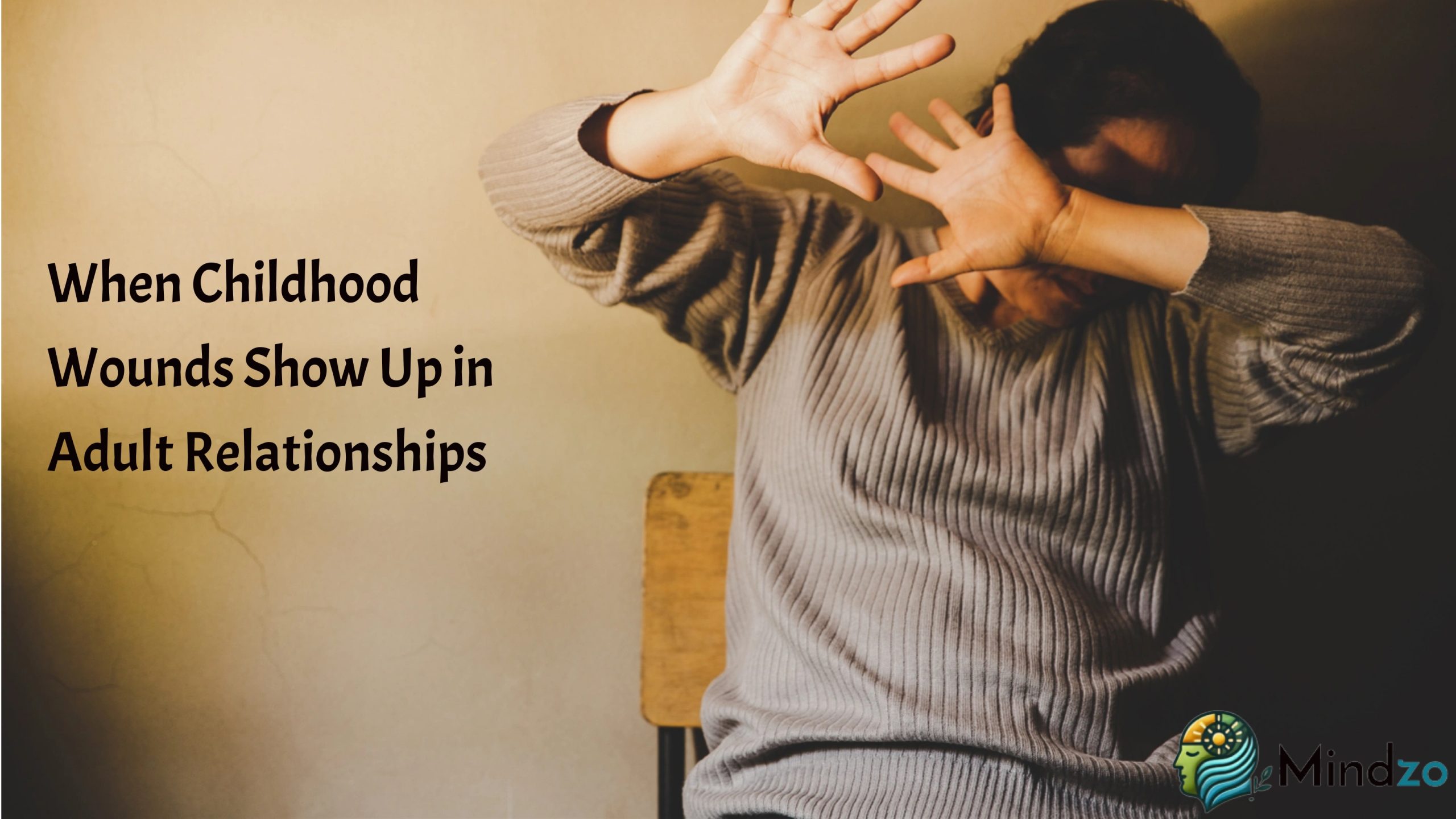When Childhood Wounds Show Up in Adult Relationships

You’re in a perfectly good relationship, yet you find yourself constantly waiting for the other shoe to drop. Or maybe you’re the one who can’t seem to stop fixing your partner’s problems, even when it drains you completely. Perhaps you notice yourself replaying the same painful relationship patterns with different people, wondering why you keep attracting the same type of partner or why every relationship ends the same way.
These patterns aren’t random, and they’re not character flaws. They’re echoes of your childhood – adaptive strategies that once helped you survive difficult situations but now sabotage your adult connections. Understanding how childhood wounds shape adult relationships isn’t about blaming your parents or dwelling in victimhood. It’s about recognizing the invisible blueprints that guide your relationship behaviors, often without your conscious awareness.
The Architecture of Early Attachment
Before we can understand how childhood wounds manifest in adult relationships, we need to grasp a fundamental truth: our most developmentally important relationships begin in our formative years and come from our teachers, mentors, friends, and our parents or parental figures, and how we connect with others is tied to what we are taught in these early years.
Think of early childhood as the construction phase of your relational operating system. During these formative years, you’re not just learning facts about the world – you’re learning fundamental truths about relationships themselves. Am I safe? Are people trustworthy? Is love conditional or unconditional? Do I matter? These aren’t questions you consciously ask, they’re conclusions your young brain draws from thousands of interactions with caregivers.
Attachment refers to a psychobiological principle deeply rooted in evolutionary development, and within individual development it indicates a primary motivational system. This system doesn’t switch off when you become an adult. Instead, it continues operating beneath your conscious awareness, influencing everything from whom you’re attracted to, how you respond to conflict, and whether you can trust vulnerability.
According to Bowlby’s attachment theory, attachment relationships formed with caregivers in early childhood serve as the foundation for an individual’s internal working model, significantly affecting their future life and the underlying model of their marital relationships. This internal working model is like a mental blueprint – a set of expectations and beliefs about how relationships work based on your earliest experiences.
When Childhood Trauma Creates Adult Relationship Patterns
An overarching theme of unresolved childhood trauma can manifest in our adult relationships as traumatic bonding and a compulsion to unconsciously repeat our unresolved core wounds. This repetition isn’t masochism or stupidity – it’s your psyche’s attempt to master what it couldn’t resolve in childhood. Your unconscious mind keeps creating similar situations, hoping for a different outcome this time.
Various traumatic experiences during childhood, such as abuse/neglect, death/separation of parent, or witnessing domestic violence, may lead individuals to develop insecure attachment styles in their future romantic relationships. The specific type of childhood experience often shapes the specific adult pattern that emerges.
The Anxious Attachment Pattern: The Hypervigilant Lover
If your early caregivers were inconsistent – sometimes available, sometimes absent, sometimes loving, sometimes cold – you might have developed what psychologists call an anxious attachment style. As a child, you never knew which version of your parent you’d get, so you learned to become hypervigilant, constantly reading emotional cues and adjusting your behavior to maximize the chance of receiving love and attention.
In adult relationships, this manifests as:
- Constant need for reassurance that your partner loves you
- Overanalyzing texts, tone of voice, and facial expressions for signs of withdrawal
- Feeling anxious when your partner needs space or independence
- Tendency to become clingy or demanding when you feel insecure
- Difficulty trusting that love is stable and won’t suddenly disappear
You’re not “needy” or “insecure” by nature – you’re operating from a nervous system that learned early that love is unpredictable and must be constantly secured. The child who had to work hard for inconsistent attention becomes the adult who works overtime to maintain connection, often paradoxically pushing partners away with the very behaviors meant to keep them close.
The Avoidant Attachment Pattern: The Emotional Fortress
If your early caregivers were emotionally unavailable, dismissive of your needs, or punished you for showing vulnerability, you might have learned that depending on others leads to pain and disappointment. Physically abused children may feel that they are worthy of attention, even if it is harsh and punitive, and may develop an active fear of closeness leading to avoidance in relationships.
The coping strategy? Build walls. Become self-sufficient. Don’t need anyone. In adult relationships, this pattern shows up as:
- Discomfort with emotional intimacy or deep vulnerability
- Tendency to withdraw when partners get “too close”
- Valuing independence and autonomy above connection
- Difficulty expressing emotions or asking for help
- Feeling suffocated or trapped by relationship demands
- Intellectualizing feelings rather than experiencing them
You’re not cold or unloving – you’re protecting yourself using strategies that once kept you safe. The child who learned that vulnerability equals pain becomes the adult who equates emotional independence with safety, often leaving partners feeling shut out and unimportant.
The Disorganized Attachment Pattern: The Approach-Avoid Dance
Perhaps the most challenging pattern emerges when early caregivers were both the source of comfort and the source of fear – such as when a parent was abusive or when severe neglect alternated with intense connection. In many instances, experiencing childhood trauma can result in the development of a disorganized attachment style.
This creates an impossible psychological bind: you desperately need the very person who hurts you. In adult relationships, this manifests as:
- Intense push-pull dynamics – craving intimacy then panicking and withdrawing
- Difficulty regulating emotions during conflict or closeness
- Tendency toward chaotic or dramatic relationship patterns
- Mixing up intensity with intimacy
- Attraction to partners who are inconsistent or emotionally volatile
- Feeling simultaneously desperate for connection and terrified of it
This isn’t “drama-seeking” – it’s a nervous system that learned early that love and pain are intertwined, that the people who should protect you might also hurt you. The resulting confusion creates adult relationships that feel familiar in their instability.
The Codependency Trap: When Care-Taking Becomes Identity
Codependency is a response to trauma wounds to our young psyche in childhood and starts in childhood, usually because of codependent parenting, including being raised by an addict or mentally or emotionally ill parent.
If you grew up in a home where you had to monitor a parent’s mood, manage their emotions, or take care of siblings beyond age-appropriate responsibilities, you might have learned that your value comes from what you do for others rather than who you are. Children may prioritize their parents’ needs over their own, suppressing their feelings to maintain harmony, promoting codependent traits such as low self-esteem, people-pleasing behaviors, and weak boundaries.
In adult relationships, childhood codependency patterns appear as:
Excessive care-taking: You feel responsible for your partner’s happiness, health, and success. When they’re upset, you immediately try to fix it, even if it means abandoning your own needs or boundaries.
Identity fusion: You struggle to separate your feelings from your partner’s feelings. Their bad day becomes your bad day. Their problems become your emergency. You’ve lost track of where you end and they begin.
Compulsive rescuing: You’re attracted to partners who need fixing, saving, or healing. Unconsciously, you recreate your childhood role of being needed, which feels like love because it’s familiar.
Boundary dissolution: People-pleasers often struggle to set boundaries, leading to feelings of resentment and burnout, with relationships becoming unbalanced and one person assuming the caretaker role.
Fear-based decision making: You say yes when you mean no, avoid conflict at all costs, and adjust yourself constantly to keep the peace, just as you did in childhood to maintain safety.
Trauma physically changes the brain, especially the prefrontal cortex, which aids in self-control and decision-making, and the amygdala, which regulates our fear reactions. This means codependency isn’t a choice or a personality flaw – it’s a neurobiological adaptation to early relational trauma.
The People-Pleasing Pattern: Earning Love Through Performance
Closely related to codependency but distinct in focus, people-pleasing emerges when childhood love felt conditional – when you had to be good, achieve, or perform to receive affection and approval.
A child learns to abandon their own needs in order to gain some feeling of safety and control, realizing they can’t count on their own needs being met by the adults in their life. If your parents’ love seemed to depend on your grades, your behavior, your accomplishments, or how much you didn’t “burden” them with your needs, you learned to earn love rather than receive it freely.
In adult relationships, this looks like:
- Chronic over-functioning and taking on more than your share
- Inability to say no or set limits, even when exhausted
- Seeking worth through others’ approval rather than internal validation
- Feeling like you must be perfect to deserve love
- Suppressing authentic reactions to maintain others’ comfort
- Experiencing anger and resentment that you can’t express directly
The exhausting irony is that people-pleasers often feel desperately unloved despite doing everything “right.” That’s because earned love never feels secure – you’re only as valued as your last performance. Children who grow up to be codependent tend to grow up in families where they got a certain amount of good loving contact, but at other times, the parent was not emotionally available to them, naturally producing anxiety around a fear of abandonment when this child becomes an adult.
The Repetition Compulsion: Why We Choose Familiar Pain
One of the most frustrating aspects of childhood wounds in adult relationships is the tendency to unconsciously recreate painful dynamics. You swore you’d never date someone like your unavailable parent, yet here you are, three relationships deep with emotionally distant partners. This isn’t coincidence or bad luck – it’s repetition compulsion.
Bessel van der Kolk explains that many traumatized people expose themselves, seemingly compulsively, to situations reminiscent of the original trauma, thus we often gravitate toward situations that feel comfortable and familiar, even if they perpetuate our trauma.
Why would we do this? Several reasons:
Familiarity equals safety to the nervous system: Even painful patterns feel safer than unknown territory. Your nervous system recognizes the emotional landscape of your childhood, and what’s recognizable feels safer than what’s unfamiliar, even if what’s familiar is painful.
Unconscious attempts at mastery: Your psyche keeps creating similar situations hoping to finally get it right – to make the unavailable person available, to earn the conditional love unconditionally, to be enough for the person who made you feel insufficient.
Confirmation of core beliefs: If you developed a core belief that you’re unlovable, you’ll unconsciously create situations that confirm this belief. It’s painful, but it’s less terrifying than challenging your fundamental understanding of reality.
Trauma bonding: When love and pain get wired together in childhood, intensity and volatility can feel like passion and connection in adulthood. Healthy, stable love might actually feel boring or inauthentic because it doesn’t match your template for what love “feels like.”
How Different Types of Childhood Experiences Create Specific Patterns
Neglect and abuse, and different forms of abuse, have different emotional and psychological meanings – neglect may result in the child’s feeling unwanted and discarded, whereas despite being violent and physical abuse can be severe and damaging, but it doesn’t always mean the person was fully abandoned or rejected.
Emotional Neglect: The Invisible Wound
Emotional neglect – when parents failed to attune to, validate, or respond to your emotional needs – often creates adults who:
- Struggle to identify or express their own emotions
- Feel guilty for having needs or taking up space
- Minimize their own pain and problems
- Feel invisible in relationships despite being physically present
- Have difficulty asking for help or support
Physical or Sexual Abuse: Broken Safety
Abuse in childhood shatters the fundamental sense of safety that relationships should provide. Adults who experienced abuse often:
- Experience hypervigilance in relationships, always scanning for danger
- Have difficulty trusting, even with trustworthy partners
- May dissociate during intimacy or conflict
- Feel intense shame that interferes with vulnerability
- Oscillate between tolerating too much (normalizing mistreatment) and being overly defensive
Abandonment or Loss: Fear at the Core
Whether through death, divorce, or emotional abandonment, early loss creates adults who:
- Live with chronic fear that people they love will leave
- Test partners through push-pull behaviors
- May leave relationships first to avoid being left
- Struggle with object permanence in relationships (when partner is out of sight, they feel gone forever)
- Over-attach quickly or avoid attachment completely
Enmeshment: When Boundaries Don’t Exist
If your family had no boundaries – reading your diary, making your emotions about them, involving you in adult problems – you might struggle as an adult with:
- Difficulty knowing where you end and others begin
- Feeling responsible for others’ emotions and problems
- Guilt when setting boundaries or saying no
- Attracting partners who are enmeshed or who violate boundaries
- Either completely open boundaries or rigid walls with nothing in between
The Body Keeps the Score: Physical Manifestations
Childhood relational trauma doesn’t just live in your mind – it’s stored in your body and nervous system. Trauma physically changes the brain, especially the prefrontal cortex and the amygdala, but it also affects how your body responds to relationship stress.
You might notice:
- Physical tension, stomach problems, or headaches during relationship conflict
- Difficulty breathing deeply when emotionally vulnerable
- Automatic freeze, flight, or fight responses to perceived relationship threats
- Dissociation or numbness during moments that require presence
- Chronic fatigue from hypervigilance or emotional suppression
Your body remembers what your mind might have forgotten or minimized. When adult relationship situations trigger childhood wounds, your body responds as if you’re facing the original threat, even when your adult brain knows you’re safe.
Breaking the Cycle: From Unconscious Patterns to Conscious Choice
The good news is that childhood wounds, while powerful, aren’t destiny. Childhood maltreatment is not a death sentence, and many who experience maltreatment go on to be happy, healthy adults. Neuroplasticity – your brain’s ability to form new neural pathways – means you can develop new relationship patterns at any age.
Step One: Recognition Without Judgment
The first step is recognizing your patterns without shame.Even our unhelpful behavior patterns once played a meaningful role in helping us cope or adapt during earlier stages of life. Your childhood adaptations were brilliant survival strategies created by a young person doing their best in difficult circumstances.
Notice your patterns with curiosity rather than criticism:
- When do you become anxious in relationships?
- What triggers your walls going up?
- When do you abandon yourself for others?
- What relationship dynamics feel familiar, even if unhealthy?
Step Two: Connect Past to Present
Draw explicit connections between your childhood experiences and current patterns. This isn’t about blaming your parents or dwelling in victimhood – it’s about understanding the logic of your adaptations.
Ask yourself:
- What was I learning about relationships in my family?
- What behaviors helped me survive or feel safe then?
- How am I still using those strategies, even though my circumstances have changed?
- What would have happened if I’d acted differently as a child?
This context helps you separate the past from present. You’re not overreacting or being irrational – you’re responding to echoes of old wounds.
Step Three: Develop Earned Secure Attachment
Research suggests that the majority of children who grow up under overall positive interpersonal and social circumstances form a stable attachment security that endures throughout their life. But what if you didn’t? Earned secure attachment provides a hopeful pathway for healing and growth.
Through consistent experiences of safe, attuned relationships – whether with a therapist, partner, friend, or support group – your brain can literally rewire. You can develop new internal working models that:
- Trust that vulnerability can be safe
- Believe that your needs matter
- Understand that love doesn’t have to be earned
- Know that conflict doesn’t mean abandonment
This rewiring takes time and repetition, but it’s possible.
Step Four: Practice New Behaviors Despite Discomfort
Here’s the challenging truth: healing means doing things that feel wrong because your nervous system is calibrated to old patterns. Healthy behavior might feel weird, dangerous, or inauthentic at first.
For anxious patterns: Practice tolerating your partner’s independence without constant reassurance. Sit with uncertainty instead of immediately seeking relief through contact or checking.
For avoidant patterns: Practice staying present during vulnerability instead of intellectualizing or withdrawing. Share feelings even when every instinct says to retreat.
For codependent patterns: Learn to say no and establish limits that protect your well-being. Let others handle their own problems instead of automatically rescuing.
For people-pleasing patterns: Express your actual preferences and needs, even when it might disappoint others. Practice being imperfect and noticing you’re still worthy of love.
These new behaviors will feel uncomfortable, but discomfort doesn’t mean danger. It means growth.
Step Five: Choose Partners Consciously
One powerful way to break cycles is choosing partners consciously rather than unconsciously recreating family dynamics. This means:
- Notice who you’re attracted to and why – is it genuine compatibility or familiar dysfunction?
- Look for partners with capacity for self-reflection and growth
- Prioritize secure, consistent people even if they don’t give you the “spark” of familiar chaos
- Be willing to stay single rather than jump into relationships that repeat old patterns
Sometimes breaking the cycle means tolerating the discomfort of being alone while you heal, rather than using relationships to avoid your wounds.
Step Six: Seek Professional Support When Needed
Childhood trauma negatively impacts parent-child relationships and contributes to insecure attachment styles, affecting psychological, physiological, and behavioral development. Given this complexity, professional support is often crucial.
Therapies particularly helpful for childhood relational wounds include:
- Attachment-based therapy
- EMDR (Eye Movement Desensitization and Reprocessing)
- Internal Family Systems (IFS)
- Somatic therapy
- Emotionally Focused Therapy (EFT) for couples
- Group therapy for specific issues (codependency, adult children of alcoholics, etc.)
Healing childhood wounds isn’t something you should have to do alone. Ironically, healing relational trauma requires relationships – safe ones that provide corrective experiences.
The Gift of Awareness
Understanding how childhood wounds show up in adult relationships is itself healing. It shifts you from unconscious repetition to conscious choice. It transforms shame (“What’s wrong with me?”) into compassion (“I’m responding to old wounds in ways that once made sense”).
Your childhood patterns aren’t character defects – they’re adaptations created by a younger version of you who was doing their absolute best to survive and find love in challenging circumstances. Now, as an adult with awareness and agency, you can honor those adaptations while gently creating new ones that serve your current life better.
The wounds are real, the patterns are powerful, but neither are permanent. Every day offers new opportunities to respond differently, to choose relationships that heal rather than harm, and to build the secure attachment you may not have experienced as a child but absolutely deserve as an adult.
Your past shaped you, but it doesn’t have to script your future. The relationship patterns you learned in childhood can be unlearned. The wounds can heal. And the love you seek – consistent, safe, unconditional – can be found, first within yourself and then with others.
Resources:
National Center for Biotechnology Information (NCBI) / PubMed Central – https://www.ncbi.nlm.nih.gov
Psychology Today – https://www.psychologytoday.com
Frontiers in Psychiatry – https://www.frontiersin.org
Nature Scientific Reports – https://www.nature.com
American Psychological Association (APA) – https://www.apa.org
The Gottman Institute – https://www.gottman.com
-
 Beyond Words: The Emotional Medicine of a Simple HugOctober 27, 2025
Beyond Words: The Emotional Medicine of a Simple HugOctober 27, 2025 -
 Music’s Unique Therapeutic BenefitsOctober 23, 2025
Music’s Unique Therapeutic BenefitsOctober 23, 2025

Leave a Reply